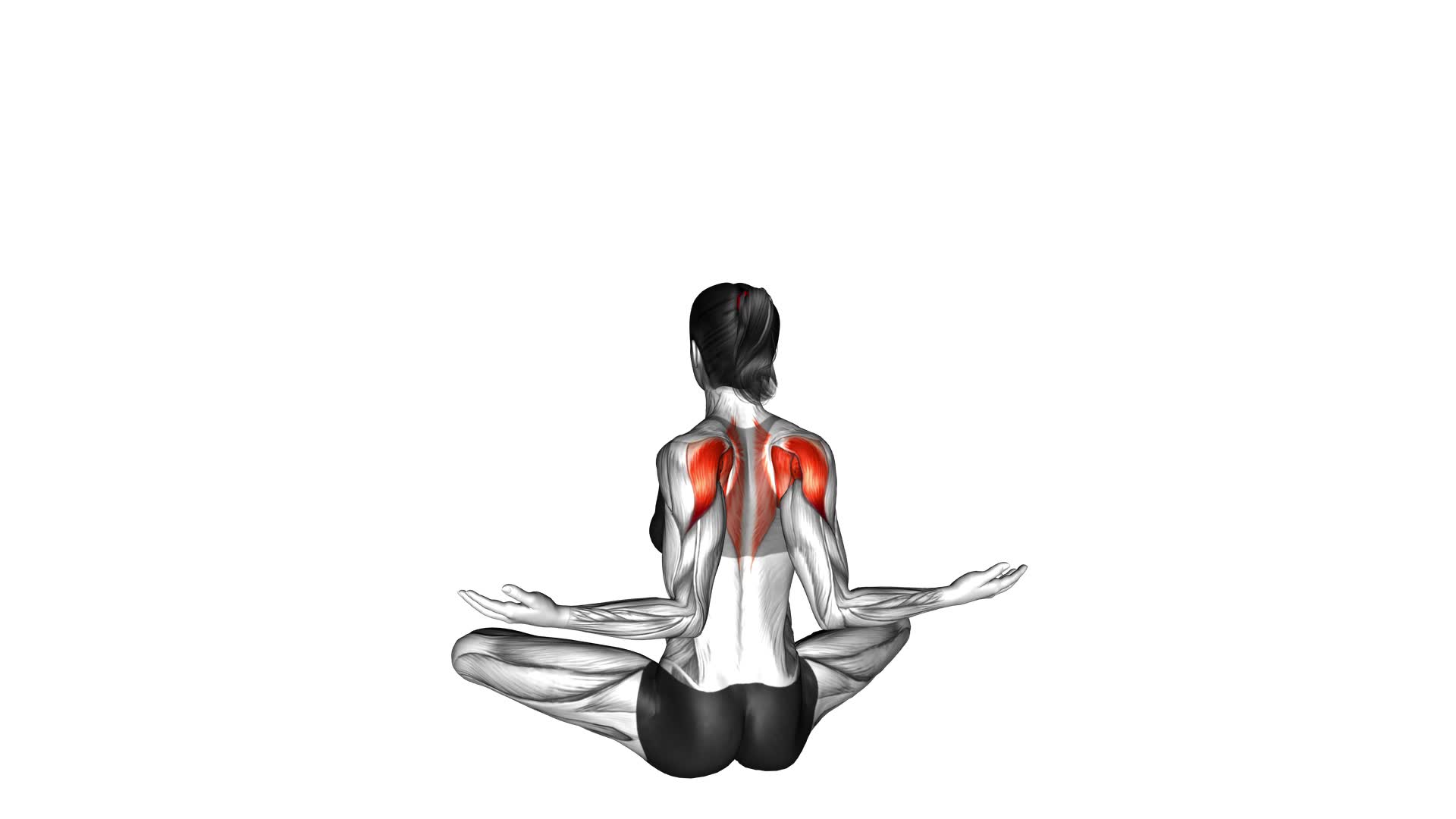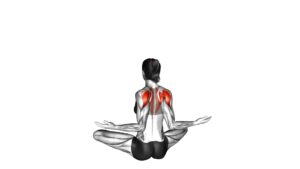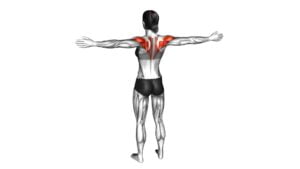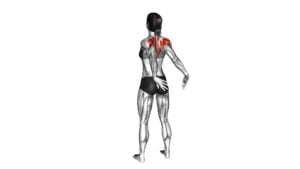Seated Back Squeeze (female) – Video Exercise Guide & Tips

Get ready to strengthen and tone your back with the Seated Back Squeeze!
Watch This Exercise Video
In this video exercise guide, we'll show you how to perform this effective exercise that targets your back muscles.
You'll learn about the benefits, proper form, and common mistakes to avoid.
Plus, we'll share tips to help you maximize your workout.
So grab a seat, watch the video, and get ready to feel the burn!
Key Takeaways
- The seated back squeeze exercise strengthens back muscles and improves posture.
- It can be done anywhere and offers variations for targeting different muscles.
- The exercise requires a stability ball and resistance band to engage core muscles and add resistance.
- Proper form, technique, and injury prevention include engaging the core, squeezing shoulder blades together, and warming up muscles before exercise.
Benefits of the Seated Back Squeeze
To experience the benefits of the Seated Back Squeeze, you should regularly engage in this exercise to strengthen your back muscles. The Seated Back Squeeze is a simple and effective exercise that can be done anywhere, whether you're at home or in the office. By incorporating variations of the seated back squeeze into your routine, you can target different muscles in your back and keep your workouts interesting. These variations include using resistance bands, adding weights, or using a stability ball.
One of the main benefits of the Seated Back Squeeze is improved posture. Many people spend long hours sitting at a desk, which can lead to poor posture and back pain. By regularly performing the seated back squeeze, you can strengthen the muscles in your back and improve your posture over time. This exercise targets the muscles that support your spine, helping to keep it aligned and reducing the strain on your back.
In addition to improving posture, the Seated Back Squeeze also helps to prevent back injuries. By strengthening the muscles in your back, you can increase your stability and support for your spine. This can help to prevent common injuries such as strains and sprains.
Equipment and Setup for the Exercise
For the exercise, you'll need a stability ball and a resistance band. These are the essential equipment options for performing the seated back squeeze exercise. The stability ball provides an unstable surface, engaging your core muscles and challenging your balance, while the resistance band adds resistance to the movement, targeting your back muscles more effectively.
When it comes to variations of the exercise, you have a few options. Firstly, you can adjust the resistance of the band by choosing a band with different levels of tension. This allows you to increase or decrease the intensity of the exercise based on your fitness level and goals. Secondly, you can experiment with different hand positions on the band to target different areas of your back. For example, a wider grip will emphasize your upper back muscles, while a narrower grip will engage your lower back muscles more.
Now that you're aware of the equipment options and variations of the seated back squeeze exercise, it's important to move on to the next section, which will cover proper form and technique. Mastering the correct form is crucial to ensure you get the most out of this exercise and avoid any potential injuries.
Proper Form and Technique
To perform the Seated Back Squeeze exercise correctly, it's important to focus on engaging your core throughout the movement. This will help maintain stability and prevent injury.
Additionally, implementing proper muscle activation cues, such as squeezing your shoulder blades together, will maximize the effectiveness of the exercise and target the intended muscles.
Core Engagement Importance
You need to engage your core properly to ensure proper form and technique during the seated back squeeze exercise. Core engagement is of utmost importance as it helps in maintaining stability and protecting your spine. Strong core muscles are essential for overall body strength and stability, making it imperative for women to focus on core exercises.
By strengthening your core, you can improve your posture, balance, and overall functional strength. It also helps in preventing injuries and reducing the risk of lower back pain. Proper engagement of your core during the seated back squeeze exercise won't only maximize the effectiveness of the exercise but also minimize the strain on other muscles.
Now, let's move on to discussing injury prevention techniques to further enhance your workout experience.
Injury Prevention Techniques
Engage your core properly during the seated back squeeze exercise to ensure proper form and technique, minimizing the risk of injury and maximizing the benefits of the workout.
Before starting any exercise, it's important to warm up your muscles and prepare your body for movement. Incorporating stretching exercises, such as shoulder rolls and neck stretches, can help to loosen tight muscles and increase flexibility. Additionally, performing warm-up techniques like jogging in place or jumping jacks can increase blood flow and raise your body temperature, which helps to prevent injuries. By incorporating these warm-up techniques and stretching exercises into your routine, you can help prevent muscle strains and ensure that your body is prepared for the seated back squeeze exercise.
Now, let's move on to muscle activation cues to optimize your workout.
Muscle Activation Cues
Start by contracting your back muscles and squeezing your shoulder blades together. To properly activate your muscles during the seated back squeeze exercise, it's important to focus on muscle activation techniques and develop a strong mind-muscle connection.
By consciously engaging your back muscles and visualizing the movement, you can enhance the effectiveness of the exercise and ensure proper form and technique. Pay attention to the feeling of tension in your back as you squeeze your shoulder blades together, and avoid using momentum or relying on other muscle groups. Maintaining control throughout the movement will maximize muscle activation and help you achieve optimal results.
Now that you understand the muscle activation cues, let's move on to modifications and progressions to further challenge yourself and continue to improve your back strength and posture.
Modifications and Progressions
Now let's explore some modifications and progressions for the seated back squeeze exercise.
If you're a beginner, there are easier modifications available to help you gradually build strength and improve your form.
On the other hand, if you're looking for a greater challenge, advanced progressions can be incorporated to keep pushing your limits and continue making progress.
Easier Modifications for Beginners
To make the Seated Back Squeeze (female) exercise more accessible for beginners, begin by using a lighter resistance band. This modification will help you build strength gradually and reduce the risk of injury. As a beginner, it's important to focus on proper form and technique before progressing to more challenging variations.
You can also modify the exercise by reducing the number of repetitions or decreasing the range of motion. Remember to listen to your body and start at a level that feels comfortable for you.
Once you feel confident and comfortable with the easier modifications, you can gradually increase the resistance or try more advanced variations for a greater challenge.
Advanced Progressions for Challenge
To further challenge yourself and continue progressing with the Seated Back Squeeze (female) exercise, consider incorporating advanced modifications and progressions.
These modifications are designed to increase the intensity of the exercise and help you achieve even greater results.
One advanced modification is to add resistance by holding a dumbbell or kettlebell in your hands while performing the squeeze. This will engage your muscles even more and make the exercise more challenging.
Another progression is to perform the exercise on an unstable surface, such as a balance board or stability ball. This will require additional core strength and stability to maintain proper form.
Common Mistakes to Avoid
To avoid common mistakes during the seated back squeeze exercise, focus on maintaining proper form and engaging your back muscles throughout the movement. Proper form is crucial for maximizing the effectiveness of this exercise and preventing injuries.
One common mistake is rounding your back or slouching during the squeeze. This not only reduces the effectiveness of the exercise but also puts unnecessary strain on your spine. To maintain proper form, sit tall with your shoulders back, chest lifted, and spine in a neutral position.
Another mistake to avoid is using your arms or shoulders to initiate the movement instead of your back muscles. Remember, the goal is to target the muscles in your back, so focus on squeezing your shoulder blades together and engaging those muscles throughout the entire exercise.
Additionally, make sure to avoid using momentum or jerking motions to complete the movement. Instead, perform the exercise in a controlled and deliberate manner.
Tips for Maximizing Your Workout
Maximize your workout by incorporating these tips into your seated back squeeze routine. These tips will help you maximize your results and improve the efficiency of your workout.
Firstly, make sure you're using proper form throughout the exercise. Sit up straight with your feet flat on the floor and your back against the chair. Engage your core and squeeze your shoulder blades together, focusing on using your back muscles. Avoid using your arms or neck to perform the movement.
Next, pay attention to your breathing. Inhale as you relax your shoulders and exhale as you squeeze your shoulder blades together. This will help you maintain control and maximize the effectiveness of each repetition.
Additionally, consider adding resistance to your workout. You can use a resistance band or dumbbells to increase the intensity and challenge your muscles. Start with a weight that allows you to perform the exercise with proper form and gradually increase the resistance as you become stronger.
Lastly, consistency is key. Aim to perform the seated back squeeze exercise at least two to three times per week to see optimal results. Remember to listen to your body and rest when needed to avoid overtraining.
Frequently Asked Questions
How Many Repetitions of the Seated Back Squeeze Exercise Should I Do?
To get the most out of the seated back squeeze exercise, it's important to know how many repetitions to do. The number of repetitions can vary based on your fitness level and goals. Generally, it's recommended to start with 10-15 repetitions and gradually increase as you get stronger.
This exercise helps improve back strength and posture, making it a great addition to your workout routine. Now, let's dive into how to properly perform the seated back squeeze exercise and the benefits it offers.
Can I Perform the Seated Back Squeeze Exercise if I Have a Back Injury?
If you have a back injury, it's important to consult with your healthcare provider before performing the seated back squeeze exercise. They can advise you on suitable alternatives or modifications that won't aggravate your injury.
The seated back squeeze exercise is generally beneficial for strengthening the back muscles and improving posture. However, your specific condition may require different exercises to ensure safe and effective recovery.
Is the Seated Back Squeeze Exercise Suitable for Beginners?
The seated back squeeze exercise is a suitable choice for beginners. It helps to strengthen your back muscles and improve posture.
To make it more accessible, you can modify the exercise by using lighter weights or even just your body weight.
The benefits of the seated back squeeze include increased back strength, reduced risk of back pain, and improved overall stability.
It's a great exercise to add to your routine, especially if you're new to fitness.
Can I Use Resistance Bands Instead of Dumbbells for the Seated Back Squeeze Exercise?
Yes, you can definitely use resistance bands instead of dumbbells for the seated back squeeze exercise. This alternative can provide similar benefits, such as improving upper back and shoulder strength, posture, and stability.
Resistance bands offer the added advantage of providing variable resistance throughout the movement, helping you build muscle endurance.
Whether using dumbbells or resistance bands, the seated back squeeze exercise targets your back muscles and can be a great addition to your workout routine.
How Often Should I Include the Seated Back Squeeze Exercise in My Workout Routine?
To maximize the benefits of the seated back squeeze exercise, it's important to consider your workout frequency and exercise variations.
Including this exercise in your routine 2-3 times per week can help strengthen your back muscles and improve posture.
You can also try different variations, such as using resistance bands or adjusting the intensity level, to keep challenging your muscles and prevent plateauing.
Remember to consult with a fitness professional to ensure proper form and technique.
Conclusion
In conclusion, the seated back squeeze is a beneficial exercise for strengthening the back muscles.
By following the proper form and technique, you can effectively target and engage the back muscles.
It can be modified and progressed based on your fitness level, and it's important to avoid common mistakes to ensure optimal results.
By incorporating these tips into your workout routine, you can maximize the benefits of the seated back squeeze exercise.

Author
Years ago, the spark of my life’s passion ignited in my mind the moment I stepped into the local gym for the first time. The inaugural bead of perspiration, the initial endeavor, the very first surge of endorphins, and a sense of pride that washed over me post-workout marked the beginning of my deep-seated interest in strength sports, fitness, and sports nutrition. This very curiosity blossomed rapidly into a profound fascination, propelling me to earn a Master’s degree in Physical Education from the Academy of Physical Education in Krakow, followed by a Sports Manager diploma from the Jagiellonian University. My journey of growth led me to gain more specialized qualifications, such as being a certified personal trainer with a focus on sports dietetics, a lifeguard, and an instructor for wellness and corrective gymnastics. Theoretical knowledge paired seamlessly with practical experience, reinforcing my belief that the transformation of individuals under my guidance was also a reflection of my personal growth. This belief holds true even today. Each day, I strive to push the boundaries and explore new realms. These realms gently elevate me to greater heights. The unique combination of passion for my field and the continuous quest for growth fuels my drive to break new ground.







